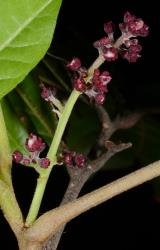- Taxon
- Gallery
- ≡ Alectryon excelsus var. grandis Cheeseman (1892)
- ≡ Alectryon grandis (Cheeseman) Cheeseman, Trans. New Zealand Inst. 44: 159 (1911 [1912])
Large shrub or small tree 2–5(–7) m tall. Mature specimens multi-trunked (very rarely single) from the base, in outline forming a broadly domed crown, often with suckering habit. Stems one or more, often distinctly curved from base and tapering, 5–12 cm diameter; with regular coppice and epicormic shoots. Branches stout, sparse, erect; young branches and branchlets with a prominent marginal flange, densely covered with velutinous, ferrugineous hairs. Outer bark, brown or blackish brown, often mottled with white, lenticellate. Cotyledons 16–19 × 6–8 mm, succulent, ovate, tip retuse, dark green. Leaves of seedlings initially a shallowly lobed terminal leaflet with two smaller basal leaflets, becoming imparipinnate, alternate; leaflets with serrate margins; indument of simple hairs along rachis and main veins (both surfaces) and scattered along lamina margin; successive leaves increasing in size; leaflets becoming entire. Sapling leaves (20–)23(–33) × (14–)24(–27) mm, leaflets 5– 9, entire, ovate-oblong, petiolules (4–)6–10 mm long, adaxial surface glabrescent, vernicose; abaxial surface dull, sparsely hirsute, hairs simple, mainly on rachis, petiolules, and main veins. Adult leaves light to dark green, vernicose, flushed rose-pink when immature, imparipinnate, alternate, (14–)35(– 70) cm long, on stout petioles 5–6 cm long. Leaflets (2–)3(–4) pairs; petiolules short, (2–)5(–6) mm long ; lamina (9–)13(–16) × (6–)8(–9) cm, subcoriaceous, broadly oblong or ovate, apex obtuse, subacute, often distinctly acuminate, acumen 15–20 mm long; base cuneate, truncate to oblique; adaxial surface vernicose, distinctly bullate in mature foliage; midribs and side veins pubescent; lamina margin usually entire, very occasionally obscurely toothed near leaflet apices. Inflorescences axillary; panicles 9–12 cm long, sparingly branched; densely velutinous, ferrugineous, interspersed with larger, strigose fulvous hairs, which become more frequent toward the apex of the panicle; bracts 2 mm long, narrowly lanceolate, densely ferrugineous hairy on both surfaces, caducous. Flowers bisexual or staminate; pedicels (0 .8–)2(–4) mm long. Sepals 5, 2–3 mm, deltoid, connate, covered in silky fulvous hairs. Petals absent. Stamens 5–8 in bisexual flowers, 6– 10 in staminate; filaments 0.5–1 mm long, base puberulent, crimson; anthers 2 mm long, dark red. Pistil 2-locular with a grooved, ovoid stigma; in staminate flowers ovary tholiform, style absent; in perfect flowers, ovary broadly urceolate, style 1.5– 2 mm long, erect. Fruits sessile, 1- or 2-lobed, 15 - 20 × 10–14 mm, pubescent, the almost globular lobes carinate, the carina 3–5 mm long on one side ; pericarp woody, splitting irregularly on one side at maturity. Seed 8–10 × (6–)7–9 mm, subglobose, slightly compressed radially, black, adaxial surface lustrous; sarcotesta covering lower third of seed or vestigal, scarlet, strongly papillose, fleshy. FL Oct - Dec, FR Dec-Apr.
[Reproduced from de Lange et al. (1999, New Zealand J. Bot. 37: 7-16) with permission from The Royal Society of New Zealand.]




